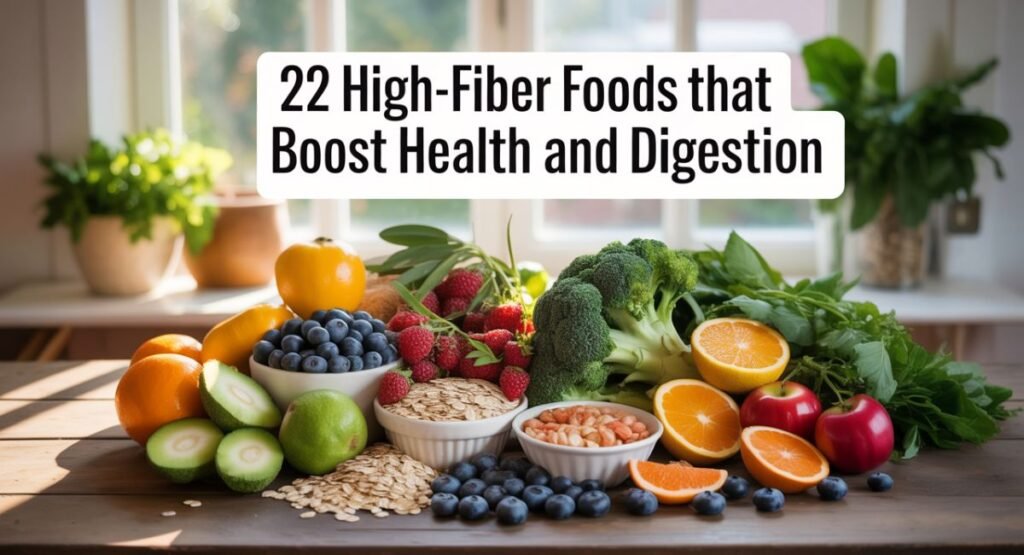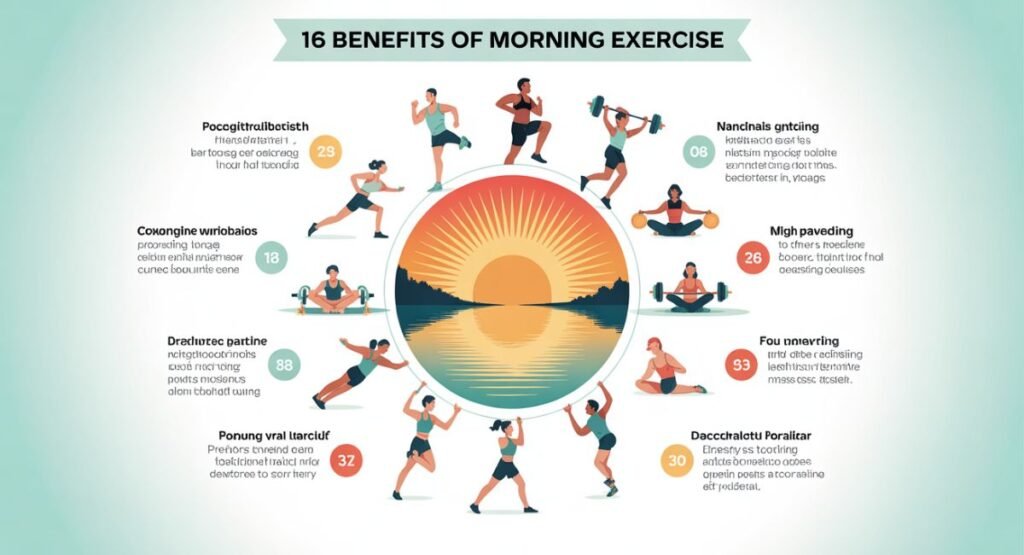Introduction
Eating high-fiber foods is one of the simplest ways to improve your health. Fiber keeps digestion smooth, supports weight control, and balances blood sugar. Most people in the USA eat far less fiber than recommended. The daily fiber intake should be around 25–38 grams. Adding the right dietary fiber sources to your meals can bring quick benefits like better gut function, fewer cravings, and a stronger heart. This article explores 22 foods that are rich in fiber and shows why they belong in your high-fiber diet plan.
When it comes to better health, nothing works quite like eating 22 High-Fiber Foods That Boost Health and Digestion. These natural choices provide essential nutrients while keeping your stomach happy and your body energized. By adding high-fiber foods into your daily meals, you can enjoy smoother digestion, lower cholesterol, and improved weight balance. Doctors often highlight dietary fiber sources because they regulate blood sugar and protect heart health. Choosing foods good for gut health isn’t complicated; it’s about simple swaps and mindful eating. With the right high-fiber diet plan, you can transform both energy and long-term wellness.
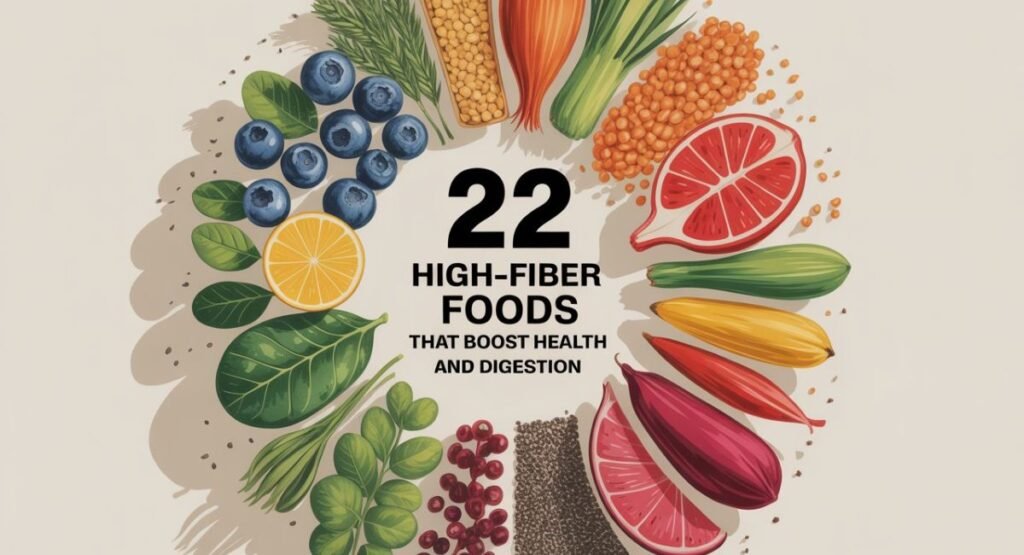
What Is Dietary Fiber, and Why Does It Matter?
Fiber is a type of carbohydrate that your body cannot fully digest. There are two kinds: soluble and insoluble fiber. Soluble fiber forms a gel-like substance in your stomach and helps lower cholesterol and blood sugar. Insoluble fiber adds bulk to stool and improves bowel movements, making it one of the best foods to relieve constipation.
Adding plant-based fiber sources also means you are protecting your long-term health. Fiber-rich diets reduce the risk of heart disease, stroke, type 2 diabetes, and even some cancers. Choosing the best foods for digestion daily can make you feel lighter, more energized, and healthier overall.
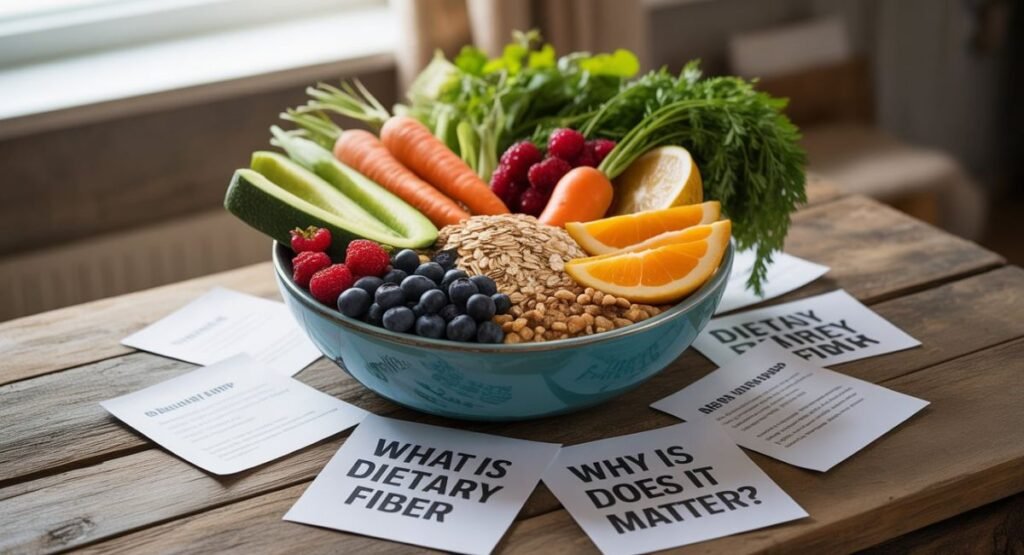
High-Fiber Fruits
Pears
Pears are a delicious fruit that provides both sweetness and bulk. The fiber in pears supports smooth digestion and keeps you full longer. Eating pears regularly is a tasty way to meet your daily fiber intake without feeling restricted.
Strawberries
Strawberries are low in calories yet high in fiber. The strawberries’ nutrition facts show that one cup provides around 3 grams of fiber along with vitamin C and antioxidants. They are among the top foods good for gut health because of their natural plant compounds.
Apples
Apples are a convenient snack with plenty of soluble fiber. The pectin in apples supports healthy digestion and also lowers cholesterol. An apple a day truly fits into a high-fiber diet plan and helps regulate blood sugar levels naturally.
Raspberries
Raspberries are rich in antioxidants along with 8 grams of fiber per cup. Their high content makes them one of the most fiber-rich mea additions for breakfast or smoothies. They are perfect foods to relieve constipation due to their bulk-forming effect.
Bananas
Bananas contain resistant starch, especially when slightly green. This resistant starch works like fiber and supports blood sugar balance. Bananas are simple, portable, and fit perfectly into fiber for weight loss strategies.
Avocado
Avocados are a superfood because they combine healthy avocado fats and fiber in one creamy package. A single avocado has 10 grams of fiber, making it an outstanding dietary fiber source. They improve cholesterol, support digestion, and keep you satisfied longer.
High-Fiber Vegetables
Carrots
Carrots are crunchy vegetables packed with vitamins and fiber. They are low in calories yet promote fullness. Carrots are also part of many fiber-rich meals, from soups to salads.
Beets
Beets not only provide fiber but also promote circulation. The beets’ blood pressure benefits are well studied. They add vibrant color, support heart health, and supply nutrients along with soluble and insoluble fiber.
Broccoli
Broccoli is acruciferous vegetable that provides fiber, vitamins, and antioxidants. Eating broccoli supports detox, gut health, and immune function. It’s one of the most powerful foods good for gut health.
Artichokes
Artichokes have one of the highest fiber contents among vegetables. They are excellent plant-based fiber sources that aid digestion and promote a healthy liver. Steamed or grilled, they provide bulk and essential nutrients.
Brussels Sprouts
The Brussels sprouts nutrition profile shows plenty of fiber, vitamin K, and antioxidants. They also contain compounds that support detox pathways, making them a valuable part of a high-fiber diet plan.
Sweet Potatoes
Sweet potatoes are rich in sweet potato resistant starch along with beta-carotene. They are perfect for fiber for weight loss because they satisfy hunger while keeping blood sugar balanced.
High-Fiber Legumes
Kidney Beans
Kidney beans are a great plant-based kidney bean protein source. They also contain fiber that lowers cholesterol and improves heart health. These beans are essential in fiber-rich meals like chili or stews.
Lentils
Lentils are packed with nutrition. A single serving provides lentils’ fiber per serving plus protein and minerals. They are one of the most versatile plant-based fiber sources for soups, curries, or salads.
Split Peas
The split pea soup nutrition profile shows high fiber content along with vitamins. Split peas create hearty meals that are filling and ideal for foods to relieve constipation.
Chickpeas
Chickpeas are famous for chickpeas’ hummus health benefits. They provide fiber, protein, and minerals. Roasted chickpeas or hummus are simple fiber-rich meals that improve gut health.
Other High-Fiber Foods
Oats
Oats are known for their beta-glucan benefits. This soluble fiber lowers cholesterol, supports digestion, and balances blood sugar. Oatmeal is one of the best foods for digestion you can eat daily.
Quinoa
Quinoa is a gluten-free grain packed with quinoa protein and fiber. It works well in salads or as a rice substitute. Adding quinoa to your high-fiber diet plan is a simple swap with big health gains.
Popcorn
Air-popped popcorn is a whole grain with fiber. It is an air-popped, low-calorie snack that supports weight control. Popcorn is one of the easiest foods to relieve constipation when eaten plain.
Almonds
Almonds offer both almond fiber and healthy fats. They are filling snacks that reduce cravings and support heart health. Nuts like almonds are excellent dietary fiber sources.
Chia Seeds
Chia seeds provide omega-3 and fiber. When soaked, they form a gel-like texture that improves digestion. Chia puddings and smoothies are tasty, fiber-rich meals for any diet.
Dark Chocolate
Dark chocolate is rich in dark chocolate antioxidants along with fiber. Choosing dark varieties above 70% cocoa makes it a delicious way to add plant-based fiber sources to your diet.
Chart of High-Fiber Foods (Quick Reference)
| Food | Fiber per Serving | Calories |
|---|---|---|
| Pears | 5.5 g | 101 |
| Raspberries | 8 g | 64 |
| Avocado | 10 g | 234 |
| Carrots | 3.6 g | 50 |
| Broccoli | 5 g | 55 |
| Lentils | 15 g | 230 |
| Chickpeas | 12 g | 269 |
| Oats | 4 g | 150 |
| Quinoa | 5 g | 220 |
| Popcorn | 3.5 g | 90 |
Health Benefits of a High-Fiber Diet
A diet full of fiber provides many benefits. It supports fiber for weight loss by keeping you full. It lowers cholesterol, which is key for fiber for heart health. It also improves blood sugar stability, making it helpful for diabetes.
Long-term studies show that eating fiber-rich diets increases life expectancy. People who focus on longevity and a fiber diet have lower risks of chronic diseases. Fiber is one of the most powerful foods good for gut health available today.
Tips to Increase Fiber in Your Daily Meals
Start small and make swaps. Replace white rice with quinoa and chips with air-popped, low-calorie snack popcorn. Add fruits and vegetables to every meal and use plant-based fiber sources like lentils in soups.
Hydration is important when eating more fiber. Water helps fiber do its job and prevents discomfort. Following a high-fiber diet plan works best with consistent daily habits.
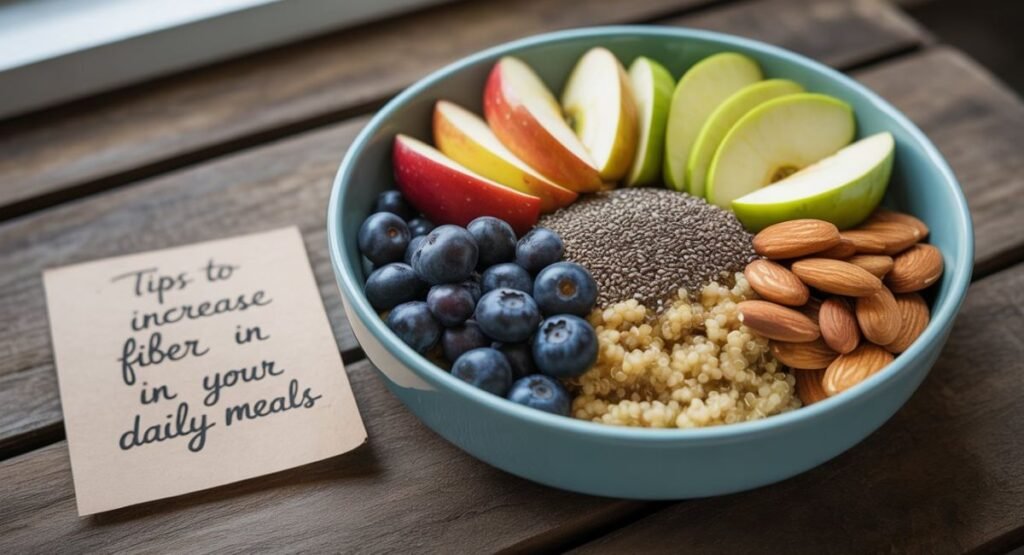
Possible Downsides and When to Limit Fiber
While fiber is good, there are times to reduce it. After some surgeries or with digestive conditions like IBS, Crohn’s, or gastroparesis, too much fiber may cause discomfort.
Doctors may also suggest limiting fiber before procedures like colonoscopies. In these cases, lowering dietary fiber sources is temporary and guided by health needs.
Frequently Asked Questions
What food is highest in fiber?
Legumes like lentils and split peas are among the highest dietary fiber sources.
What are the 10 best foods for fiber?
Foods like oats, pears, raspberries, lentils, broccoli, avocado, popcorn, almonds, chia seeds, and artichokes top the list of high-fiber foods.
How can I increase fiber naturally?
Eat more plant-based fiber sources like fruits, vegetables, legumes, and whole grains every day.
